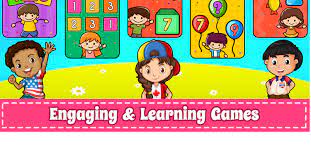
Unleashing Fun and Learning: Exploring the World of Children’s Interactive Games
Children’s Interactive Games: The Perfect Blend of Fun and Learning
In today’s digital age, children are growing up surrounded by technology. While this can be a cause for concern for some parents, interactive games have emerged as a wonderful tool to engage children in a fun and educational manner. These games not only entertain but also promote cognitive development, problem-solving skills, creativity, and social interaction.
Interactive games come in various forms, from mobile apps to console games and online platforms. They offer a wide range of experiences that cater to different interests and age groups. Whether it’s solving puzzles, exploring virtual worlds, or engaging in educational activities, there is something for every child.
One of the key benefits of interactive games is their ability to capture a child’s attention and keep them engaged for extended periods. Unlike passive forms of entertainment like television or movies, these games require active participation. This active engagement stimulates the brain and enhances critical thinking skills as children navigate through challenges and make decisions.
Moreover, interactive games often incorporate elements of storytelling, allowing children to immerse themselves in captivating narratives. By assuming the role of characters within the game world, children develop empathy and emotional intelligence as they encounter different situations and interact with virtual avatars.
Many interactive games also encourage collaboration and social interaction. Multiplayer options enable children to play with friends or even connect with new players from around the world. This fosters teamwork, communication skills, and the ability to work towards common goals – all essential skills for success in today’s interconnected world.
Educational interactive games have gained popularity as well. These games combine learning objectives with engaging gameplay mechanics. Subjects such as math, science, language arts, and history are transformed into interactive challenges that make learning enjoyable rather than tedious.
Parents can take an active role in guiding their children’s gaming experiences by selecting age-appropriate content that aligns with their educational goals. Many interactive game platforms provide parental controls that allow parents to monitor and manage their child’s gaming time, ensuring a healthy balance between play and other activities.
However, it is important to note that interactive games should be used in moderation and alongside other activities such as physical play, reading, and socializing. A well-rounded approach to a child’s development includes a variety of experiences that stimulate different aspects of their growth.
In conclusion, children’s interactive games offer a unique blend of fun and learning. They engage children actively, promote cognitive skills, foster creativity and problem-solving abilities, encourage social interaction, and even provide educational benefits. By selecting age-appropriate content and monitoring screen time, parents can harness the power of interactive games to create an enriching experience for their children. So let’s embrace the world of interactive games as a valuable tool in our children’s development journey!
7 Essential Tips for Children’s Interactive Games: Ensuring Safety, Quality, and Healthy Habits
- Choose an age-appropriate game – make sure the content is suitable for your child’s age and maturity level.
- Research the game – read reviews online to ensure that it is a quality product with positive feedback from other parents and players.
- Check the rating – make sure you understand what type of content will be included in the game, such as violence or language, before purchasing it for your child.
- Monitor playing time – set limits on how long your child can play each day so they don’t become too addicted to gaming and neglect other activities like school or outdoor playtime.
- Play together – join in with your children when they are playing interactive games to help them stay safe online, learn new skills and have fun together as a family!
- Encourage healthy habits – encourage healthy eating habits by providing snacks during gaming sessions that are low in sugar and fat but still tasty enough for children to enjoy!
- Be aware of online safety risks – make sure your child knows about privacy settings, how to avoid cyberbullying, and how not to share personal information while playing games online
Choose an age-appropriate game – make sure the content is suitable for your child’s age and maturity level.
Choosing an Age-Appropriate Game: Ensuring Fun and Safe Playtime for Kids
When it comes to children’s interactive games, one crucial tip stands out above the rest: choose an age-appropriate game. With a plethora of games available across various platforms, it’s essential to ensure that the content aligns with your child’s age and maturity level. By doing so, you can create an enjoyable and safe gaming experience for your little one.
First and foremost, consider the game’s content and themes. Different games cater to different age groups, offering varying levels of complexity and subject matter. Pay attention to the game’s rating or age recommendation provided by the relevant authorities or developers. These guidelines are designed to help parents make informed decisions about what is suitable for their child.
By selecting an age-appropriate game, you can ensure that the content is both engaging and educational without exposing your child to material that may be too advanced or inappropriate for their current stage of development. This way, they can fully enjoy the game while also learning valuable skills in a safe environment.
Another aspect to consider is the game’s difficulty level. Games that are too challenging may frustrate younger children or discourage them from continuing their gaming journey. On the other hand, games that are too easy may not provide enough stimulation for older children who crave more complex gameplay mechanics. Striking a balance between challenge and enjoyment is key when selecting a game suitable for your child’s abilities.
Keep in mind that as children grow and develop, their interests evolve as well. What might have been appropriate at one stage may no longer be engaging or relevant later on. Regularly reassessing the suitability of games ensures that your child continues to engage with content that is both enjoyable and beneficial to their development.
Lastly, don’t forget to stay involved in your child’s gaming experiences. Take time to explore the games they are playing together with them. Engage in conversations about the content, characters, and experiences they encounter. By actively participating and showing interest, you can better understand their gaming preferences and ensure that their choices align with your family values.
In conclusion, choosing an age-appropriate game is a crucial step in creating a fun and safe gaming environment for children. By considering the content, difficulty level, and your child’s evolving interests, you can make informed decisions that promote both enjoyment and educational growth. So take the time to research and select games that are suitable for your child’s age and maturity level – it’s a simple yet powerful way to enhance their interactive gaming experience!
Research the game – read reviews online to ensure that it is a quality product with positive feedback from other parents and players.
Researching Children’s Interactive Games: Ensuring Quality and Positive Experiences
When it comes to choosing interactive games for your children, it’s essential to make informed decisions. With countless options available, taking the time to research a game before introducing it to your child can help ensure a positive and enriching experience. One effective way to gather valuable insights is by reading reviews online.
Reviews provide a glimpse into the experiences of other parents and players who have already engaged with the game. By delving into these reviews, you can gain valuable information about the game’s quality, content, educational value, and overall suitability for your child.
Start by searching for reputable websites or platforms that specialize in reviewing children’s games. These platforms often provide detailed analysis, highlighting both the strengths and weaknesses of each game. Look for reviews that cover aspects such as gameplay mechanics, educational elements, age appropriateness, and any potential concerns or limitations.
Reading reviews from other parents can be particularly helpful as they offer firsthand experiences and perspectives. Look out for comments on factors like ease of use, engagement levels, potential addictive qualities, and whether the game encourages positive values such as teamwork or problem-solving skills.
Consider the overall consensus among reviewers. If multiple sources consistently praise a game for its educational value or engaging gameplay, it’s likely a good indication of its quality. On the other hand, if you notice recurring negative feedback or concerns regarding inappropriate content or excessive in-app purchases, it may be wise to reconsider that particular game.
Remember that every child is unique, so what works well for one child may not necessarily suit another. Take note of any specific details mentioned in reviews that align with your child’s interests or learning goals. This will help you select games that cater to their individual preferences while providing an enjoyable and educational experience.
In addition to reading reviews, consider exploring gameplay videos or demos available online. Watching snippets of actual gameplay can give you a better sense of the game’s mechanics, graphics, and overall user experience. This visual insight can complement the information you gather from reviews and further aid in making an informed decision.
By researching games and reading reviews, you can ensure that the interactive games your child engages with are of high quality and align with your values and expectations. This proactive approach helps create a safe and enjoyable gaming environment that supports your child’s development while providing hours of entertainment.
So, before introducing a new game to your child, take a moment to delve into online reviews. It’s a small investment of time that can lead to big rewards in terms of finding the perfect interactive games for your little ones.
Check the rating – make sure you understand what type of content will be included in the game, such as violence or language, before purchasing it for your child.
Check the Rating: Ensuring Appropriate Content for Your Child’s Interactive Games
When it comes to selecting interactive games for your child, one crucial tip stands out among the rest – checking the game’s rating. Understanding the type of content that will be included in the game, such as violence or language, is essential before making a purchase.
Video games are often assigned age ratings by regulatory bodies to help parents make informed decisions. These ratings provide valuable information about the game’s content and suitability for different age groups. By checking the rating, you can ensure that you choose games that align with your child’s maturity level and values.
The rating system typically includes symbols or labels indicating the appropriate age range for each game. For example, PEGI (Pan European Game Information) uses age categories ranging from 3+ to 18+. The Entertainment Software Rating Board (ESRB) in North America uses similar categories like “Everyone,” “Teen,” and “Mature.”
Beyond age recommendations, these ratings also provide additional details about specific content descriptors such as violence, language, sexual themes, and more. By reviewing these descriptors, you can gain a clearer understanding of what your child may encounter while playing.
It’s important to remember that every child is different and may have varying sensitivities or preferences. Some children may be more mature and able to handle certain content at an earlier age, while others may need more time before being exposed to specific themes. As a parent or caregiver, you know your child best and can make decisions based on their individual needs.
By checking the rating of interactive games before purchasing them for your child, you can ensure that they engage with content that aligns with your family values and promotes a safe and positive gaming experience. It allows you to make informed choices about what is appropriate for their age group and helps you guide their gaming experiences responsibly.
Remember that open communication with your child about video game content is also crucial. Discussing the game’s rating and content with them can help foster a healthy understanding of media consumption and enable them to make informed choices as they grow older.
So, before you bring home that new interactive game, take a moment to check the rating. It’s a simple yet powerful step towards ensuring that your child engages with games that are suitable, enjoyable, and align with your values as a family.
Monitor playing time – set limits on how long your child can play each day so they don’t become too addicted to gaming and neglect other activities like school or outdoor playtime.
Monitor Playing Time: Striking a Balance in Children’s Interactive Games
In today’s digital era, interactive games have become an integral part of children’s lives. While these games offer numerous benefits, it is crucial for parents to monitor their child’s playing time and set limits to ensure a healthy balance between gaming and other activities.
Setting limits on how long your child can play each day is essential to prevent excessive gaming and potential addiction. It is easy for children to get engrossed in the virtual worlds presented by interactive games, losing track of time and neglecting other important aspects of their lives, such as schoolwork or outdoor playtime.
By monitoring playing time, parents can encourage a well-rounded lifestyle that includes a variety of activities. It is recommended to establish clear rules and communicate them effectively with your child. Explain the reasons behind setting limits, emphasizing the importance of maintaining a balance between gaming, school responsibilities, physical exercise, social interactions, and other hobbies.
One effective way to monitor playing time is by using parental controls available on most gaming platforms. These controls allow you to set daily or weekly time limits for your child’s gaming sessions. By utilizing these features, you can ensure that your child does not spend excessive hours immersed in virtual worlds.
Encourage open communication with your child about their gaming habits. Discuss their experiences and interests in interactive games while also addressing any concerns you may have regarding excessive screen time. By involving them in the conversation and understanding their perspective, you can work together towards finding a reasonable compromise that suits both their enjoyment and overall well-being.
Remember that while interactive games offer various benefits like cognitive development and problem-solving skills, they should not overshadow other important aspects of your child’s life. Encourage them to engage in physical activities, spend time with friends and family, pursue hobbies outside of gaming, and prioritize schoolwork.
It is worth noting that every child is unique, so finding the right balance may require some trial and error. Be flexible and willing to adjust the limits as needed, taking into consideration your child’s age, maturity level, and individual circumstances.
By monitoring playing time and setting limits, parents can ensure that their child enjoys the benefits of interactive games while still participating in other important activities. Striking a balance will help foster a well-rounded development, allowing your child to thrive both in the virtual world and the real one.
Play together – join in with your children when they are playing interactive games to help them stay safe online, learn new skills and have fun together as a family!
Play Together: A Recipe for Safe, Skillful, and Joyful Interactive Gaming
In a world where technology plays a significant role in our lives, interactive games have become a popular pastime for children. As parents, it’s important to actively engage with our children when they’re playing these games. By joining in on the fun, we not only create memorable family moments but also provide guidance for their online safety, help them learn new skills, and foster a stronger bond.
Playing interactive games alongside our children allows us to monitor their online activities and ensure their safety. By being present during their gaming sessions, we can guide them on appropriate behavior, teach them about online privacy and security, and help them understand the importance of responsible digital citizenship. This involvement helps create a safe environment where they can explore the virtual world with confidence.
Moreover, playing together as a family opens up opportunities for learning new skills. Interactive games often require problem-solving, critical thinking, and strategic planning – skills that are valuable in various aspects of life. By participating in these games alongside our children, we can offer guidance and encourage them to develop these essential abilities while having fun together.
Additionally, playing together strengthens the bond between parents and children. It creates shared experiences that build lasting memories and fosters open communication. Through gaming sessions, we can better understand our children’s interests and connect with them on a deeper level. It’s an opportunity to laugh together, celebrate achievements, and support each other through challenges.
To make the most of this experience:
- Choose age-appropriate games: Select games that align with your child’s age group and interests. Look for content that is educational or promotes positive values.
- Set boundaries: Establish rules around screen time limits and ensure that gaming remains a balanced part of their routine along with other activities such as outdoor play or reading.
- Embrace cooperative play: Engage in multiplayer modes or take turns playing single-player games. Encourage teamwork, problem-solving, and healthy competition.
- Communicate openly: Use gaming sessions as a chance to talk about online safety, responsible behavior, and the importance of good sportsmanship.
Remember, playing together is not just about entertainment; it’s an opportunity to create a safe and enriching environment for our children. By actively participating in their interactive gaming experiences, we can help them navigate the digital world responsibly while building cherished memories as a family. So let’s grab those controllers, put on our game faces, and embark on an adventure together!
Encourage healthy habits – encourage healthy eating habits by providing snacks during gaming sessions that are low in sugar and fat but still tasty enough for children to enjoy!
Encourage Healthy Habits: Snack Smart During Gaming Sessions
When it comes to children’s interactive games, it’s important to not only focus on the gaming experience but also on promoting healthy habits. One area where we can make a positive impact is by encouraging healthy eating habits during gaming sessions. By providing snacks that are low in sugar and fat but still tasty enough for children to enjoy, we can ensure that they have a balanced and nutritious gaming experience.
Snacking while gaming is a common practice for many children. However, it’s essential to be mindful of the types of snacks they consume. Opting for healthier alternatives can help prevent excessive intake of sugar and unhealthy fats, which can have negative effects on their overall health.
So, what are some smart snack choices for gaming sessions? Instead of sugary treats or salty snacks, consider offering options such as fresh fruits, vegetable sticks with hummus or yogurt dip, whole-grain crackers with cheese or nut butter, or homemade popcorn without excessive butter or salt. These snacks provide essential nutrients while still satisfying cravings.
By introducing healthier snack options during gaming sessions, we can instill the importance of making mindful food choices in our children from an early age. It also helps them develop a positive relationship with food and understand that nourishing their bodies goes hand in hand with having fun.
Another tip is to involve children in the snack preparation process. Allow them to choose their favorite fruits or vegetables at the grocery store and assist in washing and cutting them. This not only encourages their involvement but also helps them develop a sense of ownership over their food choices.
It’s worth noting that moderation is key when it comes to snacking during gaming sessions. Encourage breaks between gameplay to enjoy the snacks and remind children about portion control. Balancing screen time with physical activity and other non-screen-related hobbies is equally important for maintaining overall well-being.
By incorporating healthy snack options into gaming sessions, we can create a positive environment that promotes both fun and well-being. Let’s encourage our children to make smart snack choices, fostering healthy habits that will benefit them in the long run.
Be aware of online safety risks – make sure your child knows about privacy settings, how to avoid cyberbullying, and how not to share personal information while playing games online
Ensuring Online Safety: Protecting Children in the World of Interactive Games
In today’s digital landscape, children are increasingly drawn to the world of interactive games, where they can explore virtual realms, connect with friends, and embark on exciting adventures. While these games offer countless benefits, it is crucial for parents to be aware of the potential online safety risks that accompany them.
One of the most important aspects of online safety is educating children about privacy settings. Many interactive games have built-in privacy features that allow players to control who can interact with them and access their personal information. Take the time to familiarize yourself with these settings and teach your child how to use them effectively. Encourage them to set their profiles to private and only accept friend requests from people they know in real life.
Cyberbullying is another concern that parents should address when it comes to online gaming. Teach your child about the importance of respectful behavior and kindness towards others while playing games online. Encourage open communication so that your child feels comfortable discussing any negative experiences they may encounter. Remind them that they should never engage in cyberbullying themselves and encourage them to report any instances of bullying or harassment they witness.
Furthermore, it is crucial for children to understand the importance of not sharing personal information while playing games online. Emphasize that they should never disclose their full name, address, school details, or any other sensitive information with strangers online. Teach them about the potential risks associated with sharing personal information and remind them that not everyone they encounter in the virtual world may have good intentions.
As a parent or caregiver, staying involved and engaged in your child’s gaming experiences is key to ensuring their safety. Regularly monitor their gaming activities, set time limits for gameplay, and encourage a healthy balance between screen time and other activities such as outdoor play or reading.
By being proactive about online safety education, you can help create a safe environment for your child to enjoy interactive games. Openly discuss the potential risks, establish guidelines, and encourage ongoing communication about their online experiences. Together, we can empower our children to navigate the digital world responsibly and make the most of the positive aspects that interactive games have to offer.



